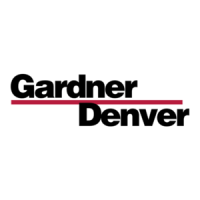Do you have a question about the Gardner Denver EBPQMC and is the answer not in the manual?
Explains the mechanical process of air compression by meshing rotors.
Describes the path of air from inlet to discharge after compression.
Details how oil is used for lubrication, heat removal, and sealing.
Explains the function of the turn valve in varying rotor volume for efficiency.
Instructions for checking unit condition upon receipt and reporting damage.
Proper methods for lifting and transporting the unit to prevent damage.
Guidelines for selecting an optimal installation area for the compressor.
Specific installation requirements for air-cooled compressor units.
Installation requirements for water-cooled compressor units.
Wiring requirements for standard units and voltage connections.
Procedure for proper lubrication of electric motor bearings.
Steps to check and service a new unit before operation.
Procedures for starting the compressor unit, including cold and hot states.
How to properly shut down the compressor unit.
Overview of compressor controls, motor, and starter components.
How to operate the Auto Sentry controller via keypad for compressor modes.
Overview of the oil system's function in cooling, lubricating, and sealing.
Information on Gardner Denver AEON™ lubricants and their benefits.
Methods for draining and cleaning the complete oil system.
Steps for safely filling the oil reservoir with lubricant.
Importance and replacement procedure for the compressor oil filter.
Description of the heavy-duty washable element dry type air filter.
When to service the air filter element based on LED or hours.
Identifies possible causes and remedies for starting failures.
Lists potential causes and solutions for intermittent operation.
Troubleshooting steps for issues with compressor loading/unloading.
Addresses problems with excessive cycling between load and unload states.
Identifies causes for reduced air delivery and pressure.
Lists causes for high discharge air temperature and solutions.
Addresses issues related to high oil consumption.
Troubleshooting steps for oil carry-over in the system.
Explains the mechanical process of air compression by meshing rotors.
Describes the path of air from inlet to discharge after compression.
Details how oil is used for lubrication, heat removal, and sealing.
Explains the function of the turn valve in varying rotor volume for efficiency.
Instructions for checking unit condition upon receipt and reporting damage.
Proper methods for lifting and transporting the unit to prevent damage.
Guidelines for selecting an optimal installation area for the compressor.
Specific installation requirements for air-cooled compressor units.
Installation requirements for water-cooled compressor units.
Wiring requirements for standard units and voltage connections.
Procedure for proper lubrication of electric motor bearings.
Steps to check and service a new unit before operation.
Procedures for starting the compressor unit, including cold and hot states.
How to properly shut down the compressor unit.
Overview of compressor controls, motor, and starter components.
How to operate the Auto Sentry controller via keypad for compressor modes.
Overview of the oil system's function in cooling, lubricating, and sealing.
Information on Gardner Denver AEON™ lubricants and their benefits.
Methods for draining and cleaning the complete oil system.
Steps for safely filling the oil reservoir with lubricant.
Importance and replacement procedure for the compressor oil filter.
Description of the heavy-duty washable element dry type air filter.
When to service the air filter element based on LED or hours.
Identifies possible causes and remedies for starting failures.
Lists potential causes and solutions for intermittent operation.
Troubleshooting steps for issues with compressor loading/unloading.
Addresses problems with excessive cycling between load and unload states.
Identifies causes for reduced air delivery and pressure.
Lists causes for high discharge air temperature and solutions.
Addresses issues related to high oil consumption.
Troubleshooting steps for oil carry-over in the system.
| Model | EBPQMC |
|---|---|
| Power Source | Electric |
| Horsepower (HP) | 5 |
| Maximum Pressure (PSI) | 175 |
| Voltage (V) | 230 |
| Phase | 1 |












